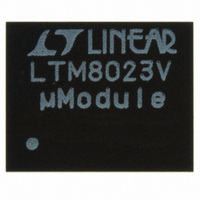LTM8023IV#PBF Linear Technology, LTM8023IV#PBF Datasheet - Page 10

LTM8023IV#PBF
Manufacturer Part Number
LTM8023IV#PBF
Description
IC BUCK SYNC ADJ 2A 50LGA
Manufacturer
Linear Technology
Series
µModuler
Type
Point of Load (POL) Non-Isolatedr
Datasheet
1.LTM8023EVPBF.pdf
(20 pages)
Specifications of LTM8023IV#PBF
Design Resources
LTM8023 Spice Model
Output
0.8 ~ 10 V
Number Of Outputs
1
Power (watts)
20W
Mounting Type
Surface Mount
Voltage - Input
3.6 ~ 36 V
Package / Case
50-LGA
1st Output
0.8 ~ 10 VDC @ 2A
Size / Dimension
0.44" L x 0.35" W x 0.11" H (11.25mm x 9mm x 2.82mm)
Power (watts) - Rated
20W
Operating Temperature
-40°C ~ 85°C
Lead Free Status / RoHS Status
Lead free / RoHS Compliant
3rd Output
-
2nd Output
-
Available stocks
Company
Part Number
Manufacturer
Quantity
Price
APPLICATIONS INFORMATION
LTM8023
Ceramic capacitors are also piezoelectric. In Burst Mode
operation, the LTM8023’s switching frequency depends
on the load current, and can excite a ceramic capacitor
at audio frequencies, generating audible noise. Since the
LTM8023 operates at a lower current limit during Burst
Mode operation, the noise is typically very quiet to a
casual ear.
If this audible noise is unacceptable, use a high performance
electrolytic capacitor at the output. The input capacitor can
be a parallel combination of a 2.2μF ceramic capacitor and
a low cost electrolytic capacitor.
A fi nal precaution regarding ceramic capacitors concerns
the maximum input voltage rating of the LTM8023. A
ceramic input capacitor combined with trace or cable
inductance forms a high Q (under damped) tank circuit.
If the LTM8023 circuit is plugged into a live supply, the
input voltage can ring to twice its nominal value, possi-
bly exceeding the device’s rating. This situation is easily
avoided; see the Hot-Plugging Safely section.
Frequency Selection
The LTM8023 uses a constant frequency PWM architecture
that can be programmed to switch from 200kHz to 2.4MHz
by using a resistor tied from the R
provides a list of R
frequencies.
Table 2. Switching Frequency vs R
10
SWITCHING FREQUENCY (MHz)
0.2
0.3
0.4
0.5
0.6
0.7
0.8
0.9
1.0
1.2
1.4
1.6
1.8
2.0
2.2
2.4
T
resistor values and their resultant
T
Value
T
pin to ground. Table 2
R
T
VALUE (kΩ)
88.7
69.8
56.2
46.4
39.2
34.6
29.4
23.7
19.6
15.8
13.3
11.5
9.76
8.66
187
124
Operating Frequency Tradeoffs
It is recommended that the user apply the optimal R
value given in Table 1 for the input and output operating
condition. System level or other considerations, however,
may necessitate another operating frequency. While the
LTM8023 is fl exible enough to accommodate a wide range
of operating frequencies, a haphazardly chosen one may
result in undesirable operation under certain operating or
fault conditions. A frequency that is too high can reduce
effi ciency, generate excessive heat or even damage the
LTM8023 if the output is overloaded or short circuited.
A frequency that is too low can result in a fi nal design
that has too much output ripple or too large of an output
capacitor.
The maximum frequency (and attendant R
the LTM8023 should be allowed to switch is given in Table 1
in the f
(and R
condition is given in the f
There are additional conditions that must be satisfi ed if
the synchronization function is used. Please refer to the
Synchronization section for details.
BIAS Pin Considerations
The BIAS pin is used to provide drive power for the internal
power switching stage and operate internal circuitry. For
proper operation, it must be powered by at least 2.8V. If
the output voltage is programmed to be 2.8V or higher,
simply tie BIAS to V
can be tied to V
cases, ensure that the maximum voltage at the BIAS pin
is both less than 16V and the sum of V
than 56V. If BIAS power is applied from a remote or noisy
voltage source, it may be necessary to apply a decoupling
capacitor locally to the LTM8023.
Load Sharing
Two or more LTM8023’s may be paralleled to produce higher
currents. To do this, tie the V
pins of all the paralleled LTM8023’s together. To ensure
T
(MAX)
value) for optimal effi ciency over the given input
column, while the recommended frequency
IN
or some other voltage source. In all
OUT
. If V
OPTIMAL
OUT
IN
, ADJ, V
is less than 2.8V, BIAS
column.
IN
OUT
and BIAS is less
T
value) at which
and SHARE
8023ff
T















